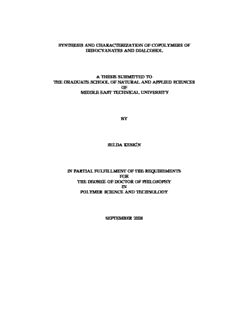
S1-Title page 1 PDF
Preview S1-Title page 1
SYNTHESIS AND CHARACTERIZATION OF COPOLYMERS OF DIISOCYANATES AND DIALCOHOL A THESIS SUBMITTED TO THE GRADUATE SCHOOL OF NATURAL AND APPLIED SCIENCES OF MIDDLE EAST TECHNICAL UNIVERSITY BY SELDA KESKİN IN PARTIAL FULFILLMENT OF THE REQUIREMENTS FOR THE DEGREE OF DOCTOR OF PHILOSOPHY IN POLYMER SCIENCE AND TECHNOLOGY SEPTEMBER 2008 Approval of the thesis: SYNTHESIS AND CHARACTERIZATION OF COPOLYMERS OF DIISOCYANATES AND DIALCOHOL submitted by SELDA KESKİN in partial fulfillment of the requirements for the degree of Doctor of Philosophy in Polymer Science and Technology Department, Middle East Technical University by, Prof. Dr. Canan Özgen Dean, Graduate School of Natural and Applied Sciences Prof. Dr. Cevdet Kaynak Head of Department, Polymer Science and TechnologyDept., METU Prof. Dr. Ali Usanmaz Supervisor, Chemistry Dept., METU Examining Committee Members : Prof. Dr. Kemal Alyürük Chemistry Dept., METU Prof. Dr. Ali Usanmaz Chemistry Dept., METU Prof. Dr. Arife Doğan Prosthodontics Dept., Gazi University Prof. Dr Duygu Kısakürek Chemistry Dept., METU Assoc. Prof. Dr. Hasan Nur Testereci Chemistry Dept., Kırıkkale University Date : I hereby declare that all information in this document has been obtained and presented in accordance with academic rules and ethical conduct. I also declare that, as required by these rules and conduct, I have fully cited and referenced all material and results that are not original to this work. Name, Last Name : Selda Keskin Signature : iii ABSTRACT SYNTHESIS AND CHARACTERIZATION OF COPOLYMERS OF DIISOCYANATES AND DIALCOHOL Keskin, Selda Ph.D., Department of Polymer Science and Technology Supervisor: Prof. Dr. Ali Usanmaz September 2008, 184 pages This study was aimed to synthesize low molecular weight hydroxyl terminated polyurethane acrylate polymers that can be used in biomedical applications. Acrylate end capping via inter-esterification reaction was successfully achieved with the methacryloyl chloride addition to the hydroxyl ends of the polyurethane at low temperatures. Isocyanate terminated polyurethane acrylates were also synthesized for the sake of comparison. TDI, HDI and MDI were used as diisocyanates for urethane synthesis and they were end capped with MMA and HEMA. Nature of the monomers used had an effect on thermal, morphological, and rheological properties that were interpreted in terms of the level of hydrogen bonding and degree of phase separation. iv Synthesized polymers were characterized by NMR, FTIR-ATR, DSC, TGA, GPC, Mass Spectroscopy, SEM and rheometry. In the literature, polyurethane acrylate polymers have been synthesized from the isocyanate terminated polyurethanes in which the urethane chains were ended with isocyanate groups. However, the toxicity of the isocyanate groups limited their biomedical applications especially in prosthetic dentistry as a soft lining material. Therefore, it is inevitable to explore the cytotoxicity of polyurethane acrylate polymers. For this purpose, silver nanoparticles that have an average particle size of 40 nm, were incorporated to the synthesized polymers. This addition, which intends to improve the degree of cytotoxicity, was successful to a certain extent. Keywords: Polyurethane, acrylate end capping, biocompatibility, silver nanoparticle. v ÖZ DİİZOSİYANAT VE DİALKOL KOPOLİMER SENTEZİ VE KARAKTERİZASYONU Keskin, Selda Doktora, Polimer Bilimi ve Teknolojisi Bölümü Tez Yöneticisi: Prof. Dr. Ali Usanmaz Eylül 2008, 184 sayfa Bu çalışma, biyomedikal uygulamalarda kullanılabilecek düşük molekül ağırlıklı hidroksil sonlu poliüretan akrilat polimerlerini sentezlemeyi amaçlamıştır. İnter-esterleşme reaksiyonu ile düşük sıcaklıkta metakriloil klorürün hidroksil sonlu poliüretana eklemesiyle akrilat sonlanması başarılı bir şekilde gerçekleştirilmiştir. İzosiyanat sonlu poliüretan akrilatlar da karşılaştırma amacıyla sentezlenmiştir. TDI, HDI ve MDI, üretan sentezinde kullanılan diizosiyanatlardır ve akrilat sonlandırması MMA ve HEMA kullanılarak yapılmıştır. Kullanılan monomerlerin ısıl, morfolojik ve reolojik özelliklere etkisi hidrojen bağının seviyesine ve faz ayrım derecesine göre değerlendirilmiştir. Elde edilen polimerler NMR, FTIR-ATR, DSC, TGA, vi GPC, Kütle Spektrometresi, SEM ve reometre analizleriyle karakterize edilmiştir. Literatürde poliüretan akrilat polimerleri, zincir sonları izosiyanat gruplarıyla sonlanmış poliüretanlardan sentezlenmektedir. İzosiyanat gruplarının toksisitesi, bu poliüretanların özellikle protetik diş hekimliğinde yumuşak astar malzemesi olarak kullanılmalarını sınırlandırmıştır. Bu nedenle poliüretan akrilat polimerlerinin sitotoksisite özelliklerinin araştırılması kaçınılmaz olmuştur. Bu amaçla, ortalama parçacık boyutu 40 nm olan gümüş nano parçacıkları sentezlenen polimerlere eklenmiştir. Sitotoksisiteyi iyileştirmeyi amaçlayan bu ekleme belirli oranda etkili olmuştur. Anahtar Kelimeler : Poliüretan, akrilat eklemesi, biyouyumluluk, gümüş nanopartikül. vii To my mother and To the memory of my father viii ACKNOWLEDGEMENTS I would like to express my deepest gratitude to my supervisor Prof. Dr. Ali Usanmaz for his support, encouragement, and guidance throughout the study. I am grateful to Prof. Dr. Arife Doğan for her encouragement, and advice throughout the research. She provided not only the necessary guidance, but also expanded my knowledge in many areas especially in dentistry. I would like to thank to my friend and colleague Dr. Kemal Behlülgil for his suggestions, comments and valuable contributions throughout the study and I am thankful to my friend Binnur Özkan for her moral support and help during this research. Special appreciation is due to my dear friend Serhan Demirci for his moral support, continuous encouragement, personal advices and his support on the graphics. I would like to express my appreciation to Prof. Dr. Çiğdem Erçelebi and Prof. Dr. Hayrettin Yücel for their understanding and support throughout the study and during the period of writing of my thesis. I am also grateful to METU Central Laboratory research associates and staff. Especially worth mentioning are the contributions from the following individuals: Elif Kemeröz, Dr. Elif Tarhan Bor, Assoc. Prof. Necati Özkan, Leyla Molu, Seda Bilgi, Sedat Canlı, Dr. Burcu Akata Kurç, Dr. İbrahim Çam. Help of my lab mates, Elif Vargün, Bengi Aran, Selin Kozanoğlu, and Şule Altınsoy are gratefully acknowledged. ix I would also like to thank Şükran Yılmaz from ŞAP Institute for the cytotoxicity analysis. I also want to thank to my friends Yusuf Nur for the mass spectroscopy analysis, Dr. Ertuğrul Sahmetlioğlu for the GPC analysis and Dr. Seha Tirkeş for his help and valuable discussions during this work. I am truly in debt to my mother for her endless support, understanding, and belief in me. This study was supported by the Scientific and Research Council of Turkey (TÜBİTAK) Grant No: 104T424. x
Description: